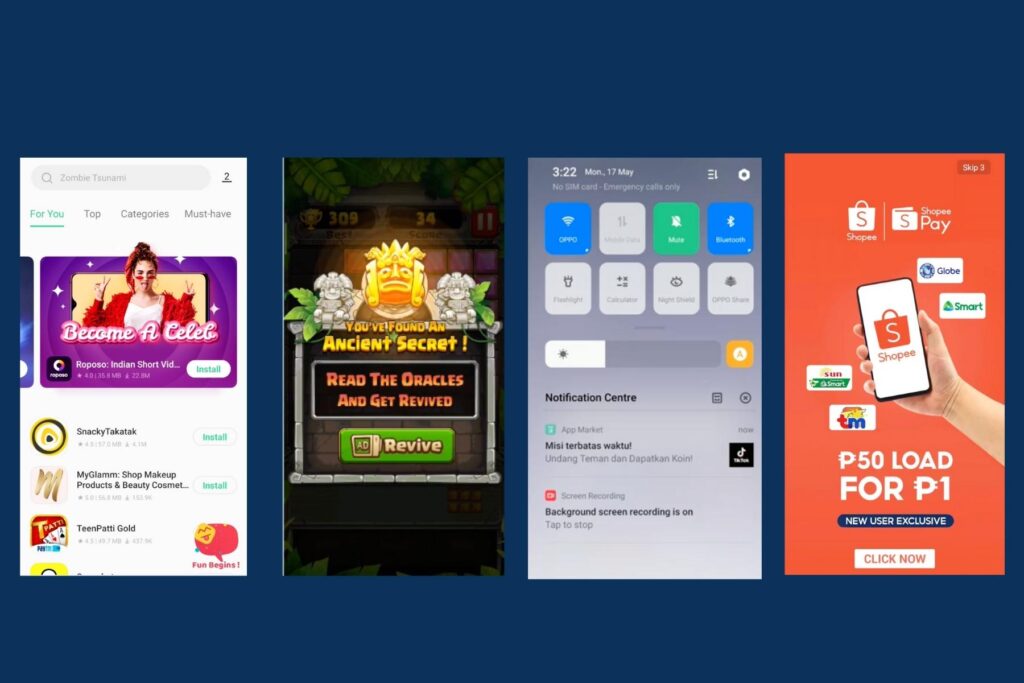How do mobile app ads work ? All you need to know to achieve your goal in 2022
Learning how mobile app adverts (ads) work is a critical step towards monetizing your app. Mobile gaming accounts for 22.98% of all app’s advertising while non-game apps make up 77.02%. But how do mobile app ads work? Whether you are marketing a mobile game or other vertical, there are fundamentals to app advertising that all advertisers need to know. This guide defines what in-app ads are, how ad networks work, cost modeling and the most popular ad formats.
What are mobile app ads?
Mobile app ads are a monetization method for mobile app publishers. App developers can provide advertising space in-app, for which they can receive payment using a pre-agreed cost model. Advertisers can work with publishers to reach their target audience. This means that app developers can simultaneously act as a publisher and advertiser, monetizing their own app while also advertising on others. So, how do mobile app ads work and why are they important?
Why are mobile app ads important?
Many mobile app developers – including 96.9% of all Android apps – are available for free. This makes it harder for paid apps to succeed in a competitive market. Many of these apps offer a freemium model, whereby users can access essential features of an app (with ads) and then pay or subscribe to upgrade to a premium service (without ads).
The ability to release a free version of your app is a significant benefit, but there are several other reasons mobile app ads are important. For example, mobile app advertising enables you to achieve a higher Click-Through Rate (CTR) compared to mobile web. A study by Opera Mediaworks found that in-app ads had CTR that was up to 1.3x higher than mobile web across all surveyed countries.
 Another critical advantage to implementing mobile app ads is the potential to increase user engagement and retention. Marketers can use enhanced targeting capabilities to reach their target audience. Intuitive ad placements and formats such as rewarded video ads can also increase engagement and retention. This has a long-term impact on Lifetime Value (LTV).
Another critical advantage to implementing mobile app ads is the potential to increase user engagement and retention. Marketers can use enhanced targeting capabilities to reach their target audience. Intuitive ad placements and formats such as rewarded video ads can also increase engagement and retention. This has a long-term impact on Lifetime Value (LTV).
When learning how mobile app ads work, it’s also important to learn about the role of ad networks. Having covered the value of mobile ads, let’s dive deeper into how they work and how ad networks can help you achieve your marketing goals.
How mobile app ads work: Ad networks
You can partner with mobile ad networks to buy and sell advertising space, including in-app advertising space, by placing the highest bid. As a publisher, you can also sell your own ad space through a network. This is why ad networks are an important component of the mobile advertising ecosystem.
Business of Apps’s Artyom Dogtiev says “The pioneer in the mobile ad networks space was AdMob, which really took off after its acquisition in 2009 by Google, Inc. Over the course of more than 10 years since, the advertising networks space has grown with a small number of top tier companies controlling the market.”
Advertisers can also work with smartphone Original Equipment Manufacturers (OEMs) such as Huawei, Oppo, Vivo, Xiaomi, OnePlus. These Mobile OEMs have their own alternative app stores that can be leveraged by marketers to reach untapped audiences at a cost effective price. Another example of a well-known Android OEM is Samsung, who sold 55.76 million smartphones in the second quarter of 2020 alone.
How do mobile app ads work? 5 critical ad formats every marketer should know
Ad formats are another important step to understanding how mobile app ads work. There are many different types of ads that can be used to reach your target audience. Here are five that every marketer needs to know and what makes them unique.
- Banner ads are traditional ads that were originally designed for desktop, and have since been adapted for mobile web and mobile apps. This places a banner image at the top or bottom of a user’s mobile screen.
- Interstitial ads are similar to banner ads, except they can expand into a full-screen experience. This can be a powerful format for getting your message heard, but the nature of these ads means that the placement and timing of interstitial ads is more important than with any other format to avoid frustrating users.
- Video ads are ads that serve a video to the user. This ad format is known for increasing engagement compared to traditional ad formats (such as banner ads) while also being more expensive.
- Native advertising is a relatively new advertising format that requires advertisers to deliver creative that matches the aesthetics and functions of the mobile app in which they are advertising. This can be pleasing to users as they are already familiar with the app and how it works. Moreover, native advertising offers potential to get creative and engage users in unique ways because it will be different on each mobile app.
- Rewarded ads can be an effective way to leverage a user’s enjoyment of a mobile game to your own advantage. This is an advertising format that rewards users for consuming ads. For example, a mobile game may reward a user with in-app currency for watching a 30-second video ad. This is a win-win scenario for the user, publisher and advertiser. The format is also a great way to cross-promote several mobile apps.
Learn how to get the most out of video ads with our guide to Leveraging user video ads on alternative app stores (OEMs).
Here are some examples of effective mobile advertisements.
How mobile app ads work: Cost models
Now that you know how to work with ad networks and critical ad formats that may be useful to your marketing strategy, you will also need to know the most popular cost models. Here are four cost models and what they mean.
- When a Cost Per Mille (CPM) model is agreed, the publisher is paid for every thousand impressions recorded on a single ad.
- When a Cost Per Click (CPC) model is agreed, the publisher is paid for every time a user clicks on an ad.
- When a Cost Per Install (CPI) model is agreed, the publisher is paid for each install that occurs as a result of an ad.
- When a Cost per Action (CPA) is agreed, the publisher is paid every time a certain action is completed in-app (after the install).
Conclusion
How do mobile app ads work? They are an important part of the mobile marketing ecosystem that enable many mobile apps to be free to download. This monetization method includes publishers with advertising space in-app, advertisers who want to promote their brand or product, and ad networks who connect them.
Ad formats available to mobile app advertisers include banner ads, interstitial ads, native advertising, rewarded video ads and several other different formats. The advertiser and publisher must also agree upon a cost model, which could be Cost Per Mille (CPM), Cost Per Click (CPC), Cost Per Install (CPI) or Cost per Action (CPA).
If you want to know how to start advertising in apps check our complete here.
About the Author






